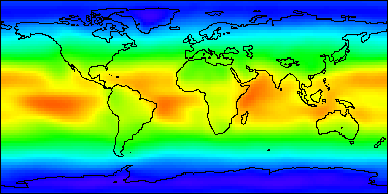The following image describes the annual pattern of solar radiation absorption at the Earth's surface for the year 1987.


Figure 7g-1: Annual (1987) pattern of solar radiation absorbed at the Earth's surface.
(Image created by the CoVis Greenhouse Effect Visualizer).
The combined effect of Earth-Sun relationships (angle of incidence and day length variations) and the modification of the solar beam as it passes through the atmosphere produces specific global patterns of annual insolation receipt as seen on Figure 7g-1 above (and see the NASA WWW links below). After examining these patterns, the following trends can be identified:
- Highest values of insolation received occur in tropical latitudes. Within this zone there are localized maximums over the tropical oceans and deserts where the atmosphere has virtually no cloud development for most of the year. Insolation quantities at the equator over land during the solstices are approximately the same as values found in the middle latitudes during their summer (see NASA WWW links below).
- Outside the tropics, annual receipts of solar radiation generally decrease with increasing latitude. Minimum values occur at the poles. This pattern is primarily the result of Earth-Sun geometric relationships and its effect on the duration and intensity of solar radiation received.
- In middle and high latitudes, insolation values over the ocean, as compared to those at the same latitude over the land, are generally higher (see NASA images). Greater cloudiness over land surfaces accounts for this variation.
NASA's Surface Radiation Budget Project has used satellite data, computer models, and meteorological data to determine shortwave surface radiation fluxes for the period July 1983 to June 1991. The following links display these fluxes for January and July globally:
Average Available Solar Insolation at the Earth's Surface: January 1984-1991 (K + k)
Average Available Solar Insolation at the Earth's Surface: July 1983-1990 (K + k)
Average Absorbed Solar Insolation at the Earth's Surface: January 1984-1991 [(K + k)(1 - a)]
Average Absorbed Solar Insolation at the Earth's Surface: July 1983-1990 [(K + k)(1 - a)]
In the equations above, the mathematical terms have the following definitions (see topic 7(i) for more information on radiation balance equations):
K = Shortwave Direct Radiation
k = Shortwave Indirect Radiation
a = Reflectivity of the Surface or Surface Albedo